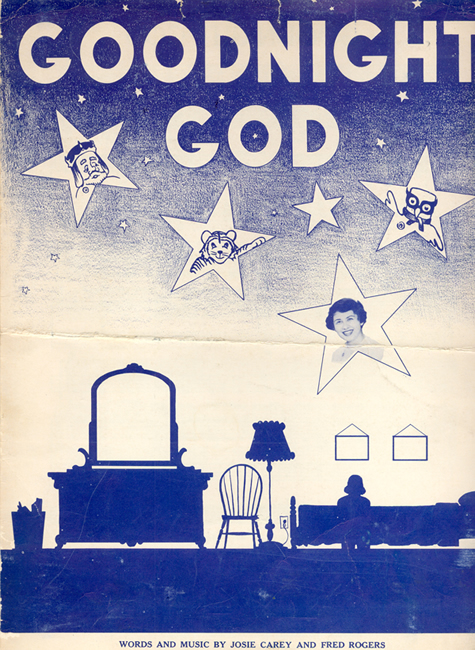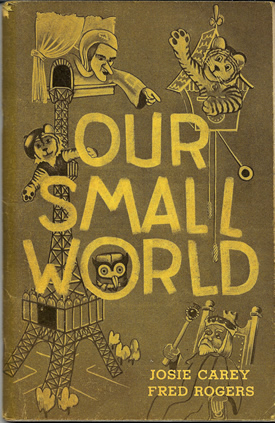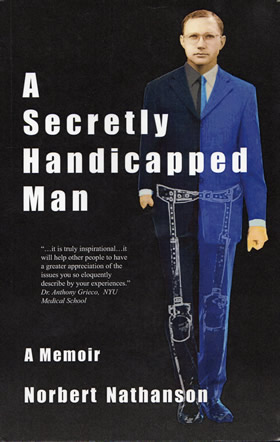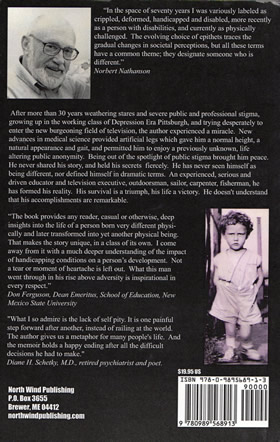Insight From a Secretly Handicapped Man
14-Feb-2014
Late last fall, I was looking at the Children's Corner book Our Small World and noticed that it was illustrated by a gentleman named Norb Nathanson.
Curious to find out more about Mr. Nathanson, I did what anyone would do and plugged his name into a Google search. Immediately, I was met with several links to a book called A Secretly Handycapped Man by Norbert Nathanson. Amazon offered a preview of the book so I was quickly able to find a reference to WQED in an early chapter confirming that the author was indeed the illustrator of Our Small World.
Of course, I couldn't stop there.
I got my hands on a copy of A Secretly Handicapped Man and found myself drawn into the inspirational and humbling memoirs of Mr. Nathanson. His life is certainly one of great accomplishment through his artistic talents and his work in education and television production. It has never been one of self-pity. The book itself offers this summary:
After more than 30 years weathering stares and severe public and professional stigma, growing up in the working class of Depression Era Pittsburgh, and trying desperately to enter the new burgeoning field of television, the author experienced a miracle. Born without feet or one hand, new advances in medical science provided artificial legs which gave him a normal height, a natural appearance and gait, and permitted him to enjoy a previously unknown, life altering public anonymity. Being out of the spotlight of public stigma brought him peace. He never shared his story, and held his secrets fiercely. He has never seen himself as being different, nor defined himself in dramatic terms. An experienced, serious and driven educator and television executive, outdoorsman, sailor, carpenter, fisherman, he has formed his reality. His survival is a triumph, his life a victory. He doesn't understand that his accomplishments are remarkable.
I recently had the honor of corresponding with Mr. Nathanson who generously agreed to offer some insight into his time working at WQED in the 1950s.
You were at WQED during its earliest days. Describe your duties and the atmosphere of the studio as this network was getting off the ground. What was most challenging? What was most enjoyable?
I'm uncertain as to when I started as a volunteer at WQED. It was sometime during the winter of 1953-4, possible early 54, some months before the station went on the air on April 4, 1954.
At the time I was free lancing as an artist and designer. The building was all torn up, in the midst of remodeling, cables and equipment lying around everywhere, engineers connecting and installing, some volunteers helping. I was shown around the building by the Volunteer Coordinator, Mrs. Lenore Elkus. The building was initially a private home in Pittsburgh's cultural center. In the twenties it was owned by the Knights of Columbus which added the ballroom that became the studio of WQED. In the large basement under the ballroom , most of which was a scene shop and storage, there were a couple rooms partitioned off, one of which was to be the art office. Then somebody got the idea that the old coal bin in the basement under the house could be used for art and it was emptied, hosed down and painted by volunteers. I was one of them. WQED had hired Rudy Bretz, at the time well known for his book about TV production and art, to set up the art and scene construction for the station. I met him and had some long talks with him, learning the pros and cons of TV art requirements which used only a six point grey scale. I got his book and studied it cover to cover. I was fascinated. It utilized everything I had learned in college and I understood it all at once.
 Volunteers worked in every aspect of the station: art and scene design, production/ direction, engineering, publicity, fund raising, and administration. Paid staff other than administration were a few engineers, one union stage hand, publicity person, photographer and a couple secretaries and financial people. Operationally, volunteers did most jobs as engineers, writers, producers, directors, announcers, performers, stagehands, floor managers, lighting, make-up, almost everything that had to do with the stations operation. Hired staff managed, instructed and advised. Initially the program manager and the production manager produced and directed, but very soon volunteers had learned to do it and training sessions were organized for anyone who wanted to learn.
Volunteers worked in every aspect of the station: art and scene design, production/ direction, engineering, publicity, fund raising, and administration. Paid staff other than administration were a few engineers, one union stage hand, publicity person, photographer and a couple secretaries and financial people. Operationally, volunteers did most jobs as engineers, writers, producers, directors, announcers, performers, stagehands, floor managers, lighting, make-up, almost everything that had to do with the stations operation. Hired staff managed, instructed and advised. Initially the program manager and the production manager produced and directed, but very soon volunteers had learned to do it and training sessions were organized for anyone who wanted to learn.
Fred [Rogers] was Director of Children's Programs and as such had great leeway as to what that should entail in the way of programs. Josie was a known local actress and she and Fred had two rooms on the second floor and had their own small group of volunteers who worked with them. Fred designated one room as the quiet room, where he or Josie, or a volunteer could go to think things out and have very little conversation.
Initially, the art consisted of scene construction, art for publicity and promotion, and opening and closing title cards for every program. As volunteer directors began to take over programs, they came to the art department to design special openings and closings for the shows and since I was there more than any other volunteer artist (they were few in number) I ended up doing most of them and was asked to coordinate the other work of the other artists.
I had been struggling to make a living for a few years as an industrial designer, (product designer), kitchen designer and graphic artist, I became intensely interested in everything about TV. As an artist, I had discovered my metier.. I wanted to know everything and do everything. I wanted to produce, direct, write; I even learned to function as an off-camera announcer. I couldn't get enough of it, my free lance art activities suffered. Occasionally the station would receive a grant for a special program or series and the station would pay me a small amount to design and paint the settings and opening and closing titles for it. Roy Nelligan would construct the settings and by helping him, I learned to do it. In a few months my career focus had changed from industrial design to television production. I was aware of it and couldn't get enough of it. It was the most rewarding and enjoyable activity I had ever known.
What were Josie Carey and Fred Rogers like to work with? Their personality, work ethic, etc.
The interest, hustle and bustle of the new station was unlike anything I had ever experienced. It was new to everyone, and everyone was eager to learn, and everyone was having a great time. Fred had recently returned from working at NBC as a floor manager for several highly popular music shows (Lucky Strike Hit Parade) and several classical music programs and so was experienced at television production. In retrospect everyone had the impression that Fred had a clear vision of what he thought children's programs should be instead of simply silliness and game playing, and how children should be treated and talked with. Josie, a cheerful, friendly, and creative improvisational performer and lyricist, with an equally respectful attitude towards children, made for a perfect team that worked well together, threw each other unexpected curves, and handled both serious and funny subjects with the same degree of respect for children. Fred's music and Josie's lyrics became a major part of the shows, and there was a continuing series of new songs that grew out of their daily experiences and Fred's characters and their values.
At the time there were several children's shows on commercial television that were variations of the traditional marionette theater featuring a responsible character (straight man?) working in front of a proscenium and a variety of puppets working within it. One of the most popular of these was Kukla, Fran and Ollie which, although comedic, was essentially conversational and featured an attractive normal woman talking to an assortment of puppets, who played within a proscenium. I've no knowledge of what influenced Fred for the Children's Corner's design, but he had to handle the hand puppets and Josie had to react to them, so Fred expanded the proscenium so that Josie was inside it (the television frame) and his characters were spread out across the background, each in their own private space, which eventually became a neighborhood, and Josie traveled around in it. Much later, when Fred came out from behind the set, he traveled around the neighborhood.

I did not have a regular day to day contact with either of them, but when either needed some kind of art work for a show, they would come to me, we'd discuss it and I'd provide what is needed, whether it was something for a show, for promotion or for an additional purpose. When they wrote what was perhaps their first song, Goodnight God, they asked me to design a cover for the printed music sheet which I did, but it was never something I perceived as being anywhere near the quality of the song. Later on, when they wanted to write their little book , Our Small World they asked me to illustrate it. It was an enjoyable project and I felt much better about my contribution to this effort.
At one point, I suggested to Fred that we could dress up the show's settings and gave him some ideas. He liked the idea and I proceeded. At several other times, Fred asked me if perhaps Grandpere could live in an Eiffel tower. It was a simple matter to paint one and Roy Nelligan put some holes in the flat. When, one day, King Friday stormed about not having a castle I built one for him. It was the first three dimensional part of the original set. The second was the knothole in the tree I "grew" for X.

Fred and Josie were always easy to work with and however light hearted and funny, both on and off camera, they were very serious about their work and how it addressed children individually and in general.
What (if anything in particular) -- literally or figuratively -- did you take away from your time at WQED. Specifically, anything you may have taken away from working directly with Fred and Josie on the Children's Corner.
As I've mentioned, my time at WQED was a turning point in my life. I found what I was capable of doing and what I wanted to spend the rest of my life doing. I spent the rest of my career trying to do that. What I learned from Fred was that, if you have strong ideas about who you are, what you stand for, and what you believe you can do, there is no alternative other than expending every effort to attempt to do it.
According to your book, your artistic creations have included the first clock lived in by Daniel Striped Tiger, Grandpere's first Eiffel Tower, the first royal castle, and the tree occupied by X the Owl. How does it feel knowing that your creations set the stage for what would eventually evolve into the iconic Neighborhood of Make-Believe?
 I'm delighted to have been a party to the early evolution of The Children's Corner. It was a special time in what was then Educational Broadcasting, and a special time in my life. Along with The Children's Corner, however, there where countess other programs that were broadcast at WQED during my tenure, as well as several others that were kineoscoped for distribution to ETV stations across the country. For each one there was a set design (in most cases a reshufflings of standard settings and props in diversified ways, each one with special needs, title cards, etc.). In the fall of 1955 I staged 35 different shows, all of which were produced, directed, set, staged, lit, and performed by volunteers. Nowhere else that I can imagine, could I have had such a total learning experience of being a volunteer art director one year and a responsible, paid, fully employed staff art director/studio director the next year. It was indeed a unique experience.
I'm delighted to have been a party to the early evolution of The Children's Corner. It was a special time in what was then Educational Broadcasting, and a special time in my life. Along with The Children's Corner, however, there where countess other programs that were broadcast at WQED during my tenure, as well as several others that were kineoscoped for distribution to ETV stations across the country. For each one there was a set design (in most cases a reshufflings of standard settings and props in diversified ways, each one with special needs, title cards, etc.). In the fall of 1955 I staged 35 different shows, all of which were produced, directed, set, staged, lit, and performed by volunteers. Nowhere else that I can imagine, could I have had such a total learning experience of being a volunteer art director one year and a responsible, paid, fully employed staff art director/studio director the next year. It was indeed a unique experience.
Where can we hear more from you? Twitter? Facebook? Website? Public speaking engagements?
I do not Twitter and am not on facebook. I have a website in the name of my book. I've spoken only twice recently, once to undergraduate and graduate would-be psychology, sociology and physical therapist students at Ithaca College, (something I've done for several years) and once to a public meeting at a local library. Plans for further talks are not yet complete.
Below is a list of websites that have responded to my memoir publication:
- Current.org - Pubcaster’s Memoir Details Creative Early Years at WQED
- Salon - I Chose to Have My Legs Amputated
- Snap Judgment - A Secretly Handicapped Man
- Penobscot Bay Pilot - Northport Resident Launches New Memoir to Rave Reviews
- Rocky Coast News - A Secretly Handycapped Man
- Pittsburgh Magazine - Small-Screen Pioneer
Mr. Nathanson also shared with me some scanned images from a few WQED programming preview guides from 1954 -- each one including a two-page spread for children featuring some wonderful references to the Children's Corner and its familiar characters. Details from these programming guides can be found HERE.
I'd like to thank Mr. Nathanson once again for his kindness and willingness to share some details about the earliest days of what eventually evolved into the most iconic Neighborhood on television.



